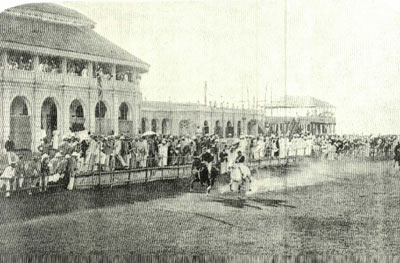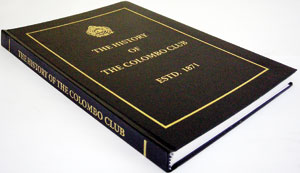A wealth of historical information
View(s):
Colombo Club: In Colonial times
That Franklyn Amerasinghe was commissioned to write the history of the Colombo Club is not surprising since he has already produced the histories of three other prestigious institutions, namely, the Employers’ Federation of Ceylon, Julius & Creasy and Ernst & Young. This publication bears the same stamp of excellence as its predecessors. Several features of the end product of his endeavours are noteworthy. First, it is well researched with reliance on vital source material, not only in respect of the Club itself, but also relative to how the Club fitted into the socio-political objectives of the British Colonial administration in Ceylon and in British colonies generally. Second, it affords a glimpse of an aspect of social life among the British expatriates, and underlines the relevance of the Club to them in the pre-independence days.
The book continues to highlight its relevance in the post-independence period after membership was opened to Sri Lankans. Third, it is consequently not only a documentation of the Club’s history from an exclusively internal point of view, but it also places the Club in its changing social context and objectives. Readers are afforded an insight into the sports, recreational and social activities which were important in the country in colonial times, and what the Club means to its members today. Constraints of space do not permit reference to the numerous interesting details as well as information it contains. The many photographs and brief pen portraits of notable individuals, both expatriate and Sri Lankan for instance, add value to the narrative.
The Club was established in 1871. The author states that one objective of the British Colonial Administration’s policy was to establish a permanent presence of the British Empire in the Colonies. The strategy, as he points out, was to attract British personnel to invest in Ceylon and make it their home. The provision of land to the British to plant coffee and later tea, spread British interests to the hill country. The planters in the hill country had their own clubs which became important centres for their social interactions. They favoured membership of the Colombo Club for the benefits it afforded them when they visited Colombo. Attracting British entrepreneurs to the Colonies was as important as having the appropriate British officials to administer and manage the affairs in the Colonies. The Club was not only a place for social interaction and sports and recreational activities, but it was also where the Colonial administrators, professionals and business expatriates could meet for both social and official purposes.

The Club had three objectives. It provided a place for recreation and business meetings in Colombo. It also provided accommodation in particular for British planters when they visited Colombo. An objective of the Colonial administration was to provide an environment conducive to the recreational and social needs of the British residents, as well as of those it sought to attract to Ceylon.
If the Club was to fulfil these objectives, it followed that membership would be confined to its own people, although membership of the Turf Club was open to Ceylonese. Notwithstanding the intention to make membership of the Colombo Club exclusive to the expatriates, the author mentions that a famous Burgher gentleman (Sir Richard Morgan) was in the first list of members. He was the Queen’s Advocate – today’s equivalent being the Attorney-General, and the first Asian in the British Empire to receive a knighthood (in 1874). As the author comments, perhaps his Welsh ancestry provided a basis for making an exception to the membership policy. There was another distinguished Burgher member of the Club – C. P. Layard, a Justice of the Supreme Court, who was also its President.
Membership of the Club was also confined to males, and ladies were not permitted entry except on rare occasions. Their presence on such occasions was frowned upon by some members. Governor Stubbs resigned from the Club in protest against ladies being allowed to attend certain social functions. Today the Club has ladies on its Committee, after membership of the Club was opened to them.
The author mentions that the local ‘elite’ responded to the restriction of the Club’s membership by creating similar clubs, one being The Orient Club founded in 1894. (The Orient Club, though also an exclusive one, was not based on ethnicity. Those familiar with the social life in Colombo in the mid-twentieth century may recall that the club was patronised by a former Prime Minister who loved his entertainment as well as by a well-known Chief Justice who used to enjoy a game of bridge and social interactions at the Club).The Orient Club denied Europeans entry to it as a part of the locals’ response to the restrictions on Ceylonese membership. The Sri Lankans also established other clubs for themselves, which largely took the form of sports clubs which also enabled social interaction. Examples include the Singhalese Sports Club, the Tamil Union, the Moors Sports Club, The Malay Sports Club, The Burgher Recreation Club, the Nondescript Sports Club, etc. It is interesting to note that Governor Gordon objected to the exclusivity of the Colombo Club in a foreign country where the purpose and interests of the Empire lay more in inclusivity rather than shutting out people who were a part of the British Empire.
At the end of British rule the Club’s relevance and the justification for its existence temporarily disappeared. The author points out that it was the efforts and determination of Singleton-Salmon [a Ceylonese at heart] that enabled the Club to find a new rationale for its existence and sustainability, and become a Club for local business people.
The author records that Singleton-Salmon’s contribution to the Club was legendary and highlights the fact that he worked tirelessly for it until his death in 1970.At one time during this period he even simultaneously functioned as its Chairman, Secretary and Treasurer. Until 1958 the office bearers of the Club were all European (with the exceptions of Morgan and Layard referred to earlier). In 1956 the first Ceylonese, Dr. H. C. P. Gunawardene, was admitted to membership.In September 1958 he was appointed to the Committee together with the leading lawyer and Judge of the Supreme Court, Noel Gratiaen. By the mid-1960s the General Committee consisted of an equal number of Europeans and Sri Lankans.
After independence the Club’s premises were returned to the Government which owned them. As the author points out, this was not because the Government wished to close down the Club, but because the building was difficult to maintain given the Club’s poor financial situation. The location of the Club was moved many times. It lacked a semi-permanent home from about the late 1950s until 2003 when it moved to the premises of the Taj Lanka Hotel where it has remained to this day. on a long lease. Many distinguished Sri Lankans such as Basil Jesudasan, David Maartensz, Ranjan Canekeratne, Mallory Wijesinghe, Reggie Candappa and C. P. de Silva, did much to ensure the continuance of the Club during its dark days. The author mentions that in particular Reggie Candappa’s efforts breathed new life into the Club, through his promotion of membership and the development of pride in the Club among its members.

The Club also has several Reciprocal Clubs in Asia, Europe, the USA, Canada and South Africa, which were entitled to reciprocal facilities at the Colombo Club in return for the facilities afforded by such clubs to the members of the Colombo Club. The author lists 60 such clubs. It is interesting to note that one such Reciprocal Club in the UK which is very exclusive counting royalty among its members, continues to prohibit women from membership.
Looking to the future and noting also that the Club’s financial position is stronger than ever before, the author states that the orientation of the Club is geared to providing services beneficial to the majority of members. As for the relevance of a Club of this nature in modern times in Sri Lanka, the author states that “the Members were convinced of the advantage a Club of this kind had in providing a meeting place for business people, which could retain its identity as a preferred place for such persons and where instead of excluding the ladies who are now becoming an important segment of the business and professional communities, they could be welcomed to create a core of influential leaders who could share information and experiences in an uninhibited atmosphere.”
The author concludes that, “the change in the Club may have come with the realisation that what the Club wanted to do was to provide an exclusive meeting place for like-minded people and that a building of its own perhaps could be a wasteful tying up of precious money. What was needed were money-generating activities and services, and the Club has been clever in this regard. The Club is now on a sound footing and can remain so in the years to come.”
The wealth of information and knowledge contained in this book makes it an interesting read for anyone interested in the British administration in Ceylon, especially pertaining to socio-economic affairs and the social life of both expatriates and Sri Lankans.Although this reviewer is not a member of the Club, he has not infrequently visited it as a guest. He had the impression that the Club is well managed, and that those responsible for its management since its move to its present location deserve credit for it.
The book will be launched on September 23 and will be available for sale at the Colombo Club, Taj Lanka Hotel premises.
The reviewer is a former CEO of the Employers’ Federation, Deputy Director of the Employers Bureau of the ILO and Senior Advisor to the International Organiation of Employers.


